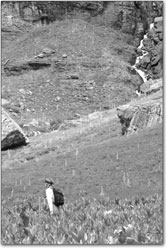|
|
||||
|
The new value of
recreation
by Will Sands Recreation just isn’t what it used to be. At least that’s the message the U.S. Forest Service sent out last week. Agency officials have drastically reduced their assessment of how much recreation on national forest contributes to the American economy. That reduction may be felt in the near term on the local San Juan National Forest. Under President Clinton, the Forest Service undertook a study to determine the monetary value of hiking, biking, fishing, hunting and other forms of recreation on national forest land. At that time, the agency’s economists figured that Forest Service recreation was responsible for a $111 billion contribution to the U.S. economy. Under the Bush administration, the economists went back and revisited the study. Not only did the new findings place a lesser value on recreation, they put the figure at one-tenth of its former value. According to the new study, the recreation is only responsible for an $11 billion slice of the national economy. Dan Jirone, the Forest Service’s national press officer, explained that there had been long-standing concerns about the Clinton numbers and that the new figure is a much more accurate one. “Even back in the 1990s, there were concerns that the number was not correct,” he said. “This is something that the agency felt was needed to be statistically accurate on and gain more confidence.” Statistical accuracy meant narrowing the parameters, according to Jirone. Under the new study, the $11 billion accounts for funds spent exclusively on national forests. “This is actual money spent on a national forest,” Jirone said. “It’s not equipment or travel expenses.” Even though the numbers dropped so dramatically, Jirone commented that recreation still has the largest economic value of all activities on Forest Service lands. By comparison, logging accounts for $4 billion and mineral extraction is responsible $3 billion. While Jirone admitted that the new $11 billion assessment could result in some funding shifts, he stressed that the Forest Service places a high value on recreation. “We knew then and know now that the demand for recreation is growing,” he said. “Recreation is still the largest chunk that we do. In terms of its impact to the budget, we know that recreation is constantly on the rise.” In spite of this statement, conservation groups and concerned citizens have seen the numbers and cried foul. Allegations that the agency has “cooked the books” to allow more mining and logging are sounding throughout the nation. Mark Pearson, executive director of the Durango-based San Juan Citizens Alliance, was shocked by the new numbers. “It’s an astonishingly big change,” he said. “To be off by a factor of 10 is unbelievable. Someone seems to have been cooking the books at some point, whether it was then or now.” Mike Francis, director of the national forest program at the Wilderness Society, suspects that the book cooking was done more recently. “The overall message of these new numbers is that this administration wants to emphasize logging and mineral development,” he said.
The dramatic drop smells a little funny to Pearson as well, especially given the Bush administration’s aggressive energy policy. “It’s a reasonable suspicion,” he said. “Clearly, this is an administration that wants to emphasize energy development at all costs. It would not be surprising that they would make up a wildly different number.” Both Pearson and Francis acknowledged that the Clinton administration’s $111 billion was probably not completely accurate. However, accounting for dollars spent only on national forest land does not convey recreation’s true economic value, they said. “It’s not an accurate picture,” Francis said. “When I visit national forest, I pack up. I have my water bottles. I have my food and equipment. I’m driving out there, and I usually need to find a private campground, because the national forest ones are full. I’ll eat in restaurants. If it’s a rainy day, you can probably find me in a shop.” Pearson agreed, saying, “Eleven billion dollars is a minisculely small piece of national recreation on national forests. The numbers for hunting and fishing in Colorado alone are several billion dollars.” Dollars that are spent on national forest rather than near it also blur the issue, according to Pearson. Citing the example of the Durango & Silverton Narrow Gauge Railroad, he commented, “It’s hard to figure things like the Durango and Silverton railroad,” he said. “You have to imagine some of the income is because the train goes through a spectacular national forest. You’d think if it was the Durango to Aztec railroad, it wouldn’t be as highly used.” Regardless of the methodology, Francis said that the new study’s findings appear to be deliberate. “I don’t think economists think this way,” he said. “It’s an extremely narrow application, and I believe it was done to undermine the Clinton study.” And the new study is already undermining the old one, according to Francis. “These numbers are already being grabbed by the timber industry to say we should increase logging,” Francis said. “This will be to the detriment of future recreation, and the last time I checked, people don’t go to see clear-cuts or well pads from oil and gas wells.” Jirone responded that these kinds of allegations are rooted in partisan politics and not in science. “I think it’s a sad commentary on the hyperbole that goes on,” he said. “The methodology that we’re using was developed by scientists and economists. We have full confidence in it.” The agency is confident enough that the new findings will play a part in the agency’s future budgeting. “There are many factors that help us determine what we request for recreation,” Jirone said. “This is a factor, one of many.” Should the diminished number lead to diminished funding, it could have harmful local consequences. The San Juan National Forest is already trying to stretch its staff to deal with a spike in off-road vehicle use. “We’re seeing a lot more motorized use all over the forest and trying to address that in a variety of ways,” said Richard Speegle, recreation project leader for the local forest. Meanwhile, the local agency is finding itself increasingly reliant on volunteers to fill staffing demands. Volunteers are particularly essential to local trail and wilderness work and as campground hosts. “We could always use more staff, especially when it comes to trails work,” Speegle said. “If it wasn’t for that volunteer program, we’d be in big trouble.” And if the San Juan National Forest is in trouble, so is the entire Four Corners region. “There’s a reason people visit Colorado rather than Kansas. It’s because of quality national forest land,” Pearson said in closing. Francis added, “The real economics here are that you can’t recreate the beauty of the Rocky Mountains anywhere else.” •
|



